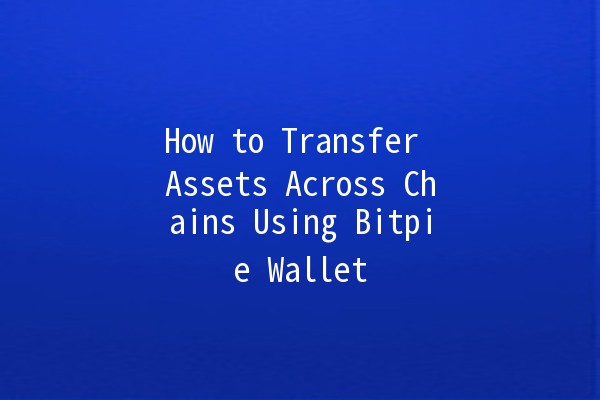
The rapid development of the cryptocurrency world has led users to seek flexibility in managing their digital assets. Crosschain transfers are becoming essential for users who want to move assets between different blockchain networks, yet many find the process daunting. This article will demystify how to use the Bitpie Wallet for crosschain transfers, providing you with practical tips and techniques to enhance your productivity.
What is Bitpie Wallet?

Bitpie Wallet is a multichain cryptocurrency wallet allowing users to store, manage, and exchange a vast array of digital assets. It supports various cryptocurrencies, including Bitcoin, Ethereum, and many others, while providing features such as crosschain transactions, which facilitate the transfer of assets between different blockchains.
Key Features of Bitpie Wallet:
Preparing for CrossChain Transfers
Before diving into crosschain transfers, it's essential to prepare adequately. Here are several productivityenhancing tips to ensure a smooth experience:
Select the cryptocurrency you wish to transfer. Research its compatibility with both the sending and receiving chains. For instance, if you want to transfer Bitcoin to Ethereum, ensure that the Bitpie Wallet supports this functionality.
Example:
To transfer Bitcoin (BTC) to Ethereum (ETH), verify that Bitpie Wallet facilitates BTC to ETH conversions directly.
Network fees can significantly affect the amount you receive when transferring assets. Check the transaction fees on both the source and destination networks to compute the total cost effectively.
Example:
If the current Bitcoin network fee is high, consider waiting for a lower fee period to maximize your asset's value during the transfer.
Before executing a large transfer, perform a test transaction with a smaller amount. This test can help you become familiar with the transfer process while minimizing potential loss.
Example:
If your plan is to transfer 1 BTC, start with a transfer of 0.01 BTC to validate the process.
StepbyStep Process for CrossChain Transfers in Bitpie Wallet
Now that we’ve covered the preparation, let’s go through the fundamental steps to perform a crosschain transfer using Bitpie Wallet.
Step 1: Open Bitpie Wallet
Login to your Bitpie Wallet. Ensure you have the latest version of the app for optimal performance.
Step 2: Navigate to Wallets
Click on the “Wallets” tab from the main dashboard where your different cryptocurrency holdings are displayed.
Step 3: Select the Asset to Transfer
Choose the asset you intend to transfer.
For example, if you want to send Bitcoin, click on Bitcoin from your wallet.
Step 4: Initiate Transfer
Tap on the “Send” button to initiate the transfer.
Enter the destination address (the address on the receiving chain).
Step 5: Choose CrossChain Option
In the options menu, select the crosschain transfer feature.
You will likely have to choose the receiving cryptocurrency.
Example:
If transferring BTC to ETH, select ETH as the receiving cryptocurrency.
Step 6: Confirm Transfer Details
Review the details carefully, including amount and destination address.
Ensure you are aware of the network fees displayed.
Step 7: Execute the Transfer
Confirm the transaction and execute the transfer.
After executing, you may receive a transaction hash to track the transfer’s status.
Step 8: Monitor the Transfer
Go back to the main wallet interface and monitor the progress of your transaction.
Wait until the status updates to “Completed” before checking the receiving wallet.
Additional Productivity Tips for Using Bitpie Wallet
Here are five productivityenhancing techniques to leverage while using Bitpie Wallet:
Keeping up with the latest trends in cryptocurrency can aid in making informed decisions regarding asset transfers and trading.
Example:
Follow cryptocurrency news channels or join community forums to stay abreast of market movements that may affect your assets.
Enable notifications in the Bitpie Wallet for transaction confirmations and market updates. This allows you to react quickly to market changes or transaction statuses without constantly checking the app.
Example:
Set alerts for significant price changes in assets you frequently use, allowing you to maximize your trading decisions.
Document your transactions, including amounts transferred, fees incurred, and timestamps. This practice aids in tracking your cryptocurrency movements and analyzing trends.
Example:
Create a simple spreadsheet to keep track of all transactions made through Bitpie Wallet, helping you identify patterns and efficiencies.
Leverage Bitpie Wallet's integrated tools, such as decentralized exchanges (DEXs), for easier conversion and trading of assets without needing to exit the wallet.
Example:
If you need to convert ETH to another token, use the DEX feature directly through Bitpie Wallet rather than transferring to an exchange.
Always update the wallet application to the latest version to benefit from security patches and new features implemented by the Bitpie development team.
Example:
Check for updates weekly to ensure you are utilizing the most efficient and secure version of Bitpie Wallet.
Frequently Asked Questions (FAQs)
A crosschain transfer is the action of moving assets from one blockchain to another. This feature is crucial for users looking to leverage different blockchain ecosystems for various functionalities.
Yes, there are risks, including potential loss of funds due to incorrect addresses, network congestion affecting transfer times, and varying fees that can impact overall asset transfers.
The time for crosschain transfers can vary based on network congestion and the blockchain protocols involved. Usually, transfers can take anywhere from a few minutes to over an hour.
No, cryptocurrency transactions are generally irreversible. Once you send assets, you cannot undo the transaction; always ensure accuracy before executing.
Fees can include network fees for the sending and receiving blockchain. It’s vital to review these fees before initiating a transfer to avoid surprises.
If you accidentally send assets to the wrong address, recovery can be difficult. It is recommended to contact the wallet's customer support or the recipient's assistance, though recovery is no guarantee.
By following the above instructions and applying the suggested productivity techniques, you can enhance your experience while transferring assets across chains using the Bitpie Wallet. This knowledge not only helps streamline your transactions but also empowers you to leverage the diverse capabilities of different blockchains effectively.

